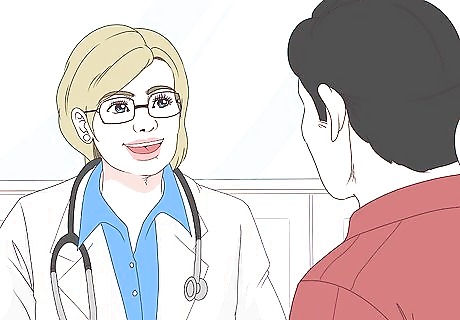
views
Changing Your Diet

Eat healthy by choosing fresh produce, lean proteins, and whole grains. Building your meals around fresh produce and whole grains may help manage your condition. A healthy diet will support your overall health and will help control your body’s inflammatory response. This may help with your sarcoidosis. Choose fresh fruits, vegetables, whole grains, poultry, fish, legumes, nuts, tofu, tempeh, and low-fat dairy.

Substitute leaner options for red meat to reduce inflammation. Unfortunately, red meat can trigger inflammation in your body. While it might not directly cause sarcoidosis, this can make it harder for you to recover. Opt for leaner proteins rather than red meat. Choose poultry, fish, tofu, legumes, beans, or nuts for your protein sources.

Use healthy oils like olive or vegetable oil to boost your good fats. Healthy fats will support your overall health and may help reduce inflammation. They also help your body process fat soluble nutrients, which will help you get the vitamins and minerals you need. When you’re cooking, use olive oil or vegetable oil. As an added benefit, healthy oils may also reduce your risk of heart disease and type 2 diabetes.

Eat antioxidant-rich foods to help control inflammation. If you’re building your meals around fresh fruits and veggies, you’re likely already eating a lot of antioxidant-rich foods. Try to include at least 1 high antioxidant food a day. This will support your overall health and possibly help you reduce your sarcoidosis symptoms. Antioxidant-rich foods include tomatoes, cherries, blueberries, bell peppers, and squash. Other fruits and vegetables also provide antioxidants, so eat them daily.

Choose magnesium-rich foods that are low in calcium for nutrient balance. Sarcoidosis may cause you to have high calcium levels because it triggers your body to process vitamin D faster. This may make your magnesium levels low. To keep your minerals balanced, eat more foods that contain a lot of magnesium but little calcium. Great options include bran, oats, corn, barley, brown rice, soy, potatoes, avocados, and bananas.

Cut out processed foods and sugar because they trigger inflammation. Processed foods may have a negative impact on your health, and they trigger your body’s inflammatory response. Additionally, they often lack nutrients. Do your best to eliminate processed foods and sugar from your diet. For instance, don’t eat packaged snacks, refined bread, baked goods, pasta, and treats.

Eliminate caffeine and alcohol because they cause inflammation. Cut out coffee, caffeinated tea, chocolate, and alcoholic beverages. This may help control your symptoms. Switch out your regular coffee for decaf, and choose caffeine-free tea. If you’re having trouble giving up alcohol, try going to a support group for help.

Drink at least 8 cups (1.9 L) of water daily to stay hydrated. Staying hydrated is great for your overall health. Plus, it helps your body keep your cells working and your digestion running smoothly. Make sure you’re drinking plenty of water and other fluids every day. Fruit, soups, and herbal teas also help keep you hydrated.
Using Herbal Remedies

Take omega-3 supplements like fish oil as a natural anti-inflammatory. Omega-3s help calm your body’s inflammatory response, so they may help with your sarcoidosis. Take a fish oil or flaxseed supplement daily. Read the label on your product and take the correct dosage. Talk to your doctor before taking any supplements. Also, be aware that omega-3s may cause bleeding issues.

Try bromelain to help reduce inflammation throughout your body. This enzyme comes from pineapples and may help fight your body’s inflammatory response. For a typical dose, take 500 mg daily. Be sure to read the label on your supplement to verify the dose. Follow the directions exactly. Check with your doctor before using any supplements. Keep in mind that bromelain can increase your risk of bleeding and may interfere with certain medications.

Use turmeric to help control your body’s inflammatory response. Turmeric, also known as Curcuma longa, is an herb that helps control inflammation. You can take it as a supplement or add it to your food as a spice. If you’re using a supplement, take 300 mg 3 times a day. If you’re using it in your food, add it to taste. Turmeric is a potent antioxidant and anti-inflammatory herb that may be helpful in treating various inflammatory disorders. Turmeric is a member of the ginger family and has been used for hundreds of years in both Ayurvedic medicine and traditional Chinese medicine.

Try cat's claw if you don’t have an autoimmune disorder or cancer. Cat's claw (Uncaria tomentosa) may also lower inflammation in your body. Take 20 mg 3 times a day to support a healthy inflammatory response. However, check with your doctor first because it’s not right for everyone. This remedy may interact with certain medications. Additionally, it’s not appropriate for people with leukemia or autoimmune conditions.

Drink chamomile tea to help you relax and to help with inflammation. Heat your water until it’s almost boiling. Then, pour the water over a bag of chamomile tea. Steep for about 3 minutes, then drink your tea while it’s comfortably hot. Chamomile tea may make you feel sleepy.
Making Lifestyle Changes

Manage your stress levels to prevent flare-ups and reduce inflammation. Stress is part of life, but it can become harmful if you experience it too much. Adopt stress relief habits that you can do every day to help you cope with stress. Here are some ways you can do that: Meditate for 10-30 minutes every day. Color in an adult coloring book. Talk to a friend. Play with your pet. Write in a journal. Read a book. Soak in a bathtub. Use aromatherapy.

Exercise for 30 minutes daily to fight fatigue and support your health. Exercise provides a lot of benefits for your body. It helps relieve your stress, reduces inflammation, improves fatigue, and boosts your mood. Additionally, it will help strengthen your respiratory system. Choose an exercise that you enjoy and that doesn’t aggravate your symptoms. Great options include yoga, walking, swimming, low impact aerobics, or dancing. Check with your doctor before beginning an exercise program, especially if you get out of breath.

Quit smoking if you do. Smoking is harmful to your lungs, so it may aggravate your sarcoidosis. Additionally, tobacco use can cause inflammation in your body. Talk to your doctor about quitting aids to help you stop. Quitting is really hard, but your doctor may be able to prescribe quitting aids like patches, gum, or prescription medication.

Avoid areas with poor air quality. Smog, smoke, and other pollutants can irritate your lungs and make the symptoms of sarcoidosis worse. Check your local weather report or look online for the daily pollution forecast and stay inside as much as possible if predictions show that smog or pollution levels will be high. You can also protect your lungs by: Exercising indoors when pollution levels are high Avoiding high-traffic areas, especially while exercising Not burning wood or trash Using hand-powered or electric lawn care equipment (such as mowers, leaf blowers, and snow blowers) rather than gasoline-powered ones Asking people not to smoke in your home or car and staying away from indoor areas where smoking is allowed
When to Seek Medical Care

See your doctor if you have the symptoms of sarcoidosis in your lungs. You need to get your condition diagnosed by a doctor so you know you’re getting the right treatment. Sarcoidosis shares symptoms with other conditions, and your doctor needs to rule those out. Call your doctor if you notice the following symptoms: Persistent dry cough Chest pain Shortness of breath Wheezing Fatigue Swollen lymph nodes Weight loss Night sweats Joint painTip: You’ll likely need to see your doctor regularly for checkups, even if you’re treating your symptoms naturally. Your doctor will monitor your condition so you can make changes to your treatment plan if necessary.

Undergo diagnostic tests to get a diagnosis. After you tell your doctor about your symptoms, you’ll likely need some diagnostic tests. This will help rule out other conditions and check if you have granulomas in your lungs. Your doctor may do the following tests: A simple blood test to check for an infection and determine how well your organs are functioning. Imaging tests like X-rays or a CT-scan to check your lungs. Lung function tests to check how much air you can take in and release. A biopsy to check your lung tissue for sarcoidosis.

Ask your doctor about treatments for your underlying condition. While you may be able to use natural treatments to manage your sarcoidosis, your doctor may recommend you take medication if you have certain underlying conditions. Take your medications exactly as directed, and don’t stop taking them without your doctor’s permission. Your doctor may recommend pulmonary rehabilitation to help improve your breathing. They may prescribe corticosteroids, which are strong anti-inflammatories. If your condition is autoimmune, your doctor may give you immune suppressors like methotrexate (Trexall) and azathioprine (Azasan, Imuran) to help reduce the inflammation. Depending on the cause of your condition, your doctor may recommend other medications to help relieve your symptoms. Your doctor may give you tumor necrosis factor-alpha (TNF-alpha) inhibitors if other treatments aren’t helping.

Talk to your doctor about a transplant if your lungs are damaged. While you likely won’t need to worry about it, your lungs may become damaged by sarcoidosis. When this happens, you may be able to get a transplant. If you’re struggling to breathe, ask your doctor if this might be a treatment option for you. Lung transplants are rarely necessary as a treatment for sarcoidosis, so try not to worry about it.



















Comments
0 comment